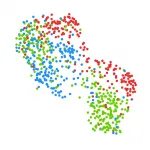Tectonic and eustatic control of Mesaverde Group (Campanian-Maastrichtian) architecture, Wyoming-Utah-Colorado region, USA
Keith P. Minor; Ronald J. Steel; Cornel Olariu
Abstract: We describe and analyze the depositional history and stratigraphic architecture of the Campanian and Maastrichtian succession of the southern greater Green River basin of Wyoming, USA, and surrounding areas to better understand the interplay between tectonic and eustatic drivers that built the stratigraphy. By integrating new measured sections with published outcrop, well-log, and paleogeographic data, two new stratigraphic correlation diagrams, 35 new paleogeographic reconstructions, and six new tectonic diagrams were created for this part of the Western Interior Seaway. From this work, two time-scales of organization are evident: (1) 100−300 k.y.-scale, mainly eustatically driven regressive-transgressive shoreline oscillations that generated repeated sequences of alluvial-coastal plain-shoreline deposits, passing basinward to subaqueous deltas, then capped by transgressive estuarine/barrier lagoon deposits, and (2) 3.0−4.0 m.y.-scale, tectonically driven groups of 10 to 15 of these eustatically driven units stacked in an offset arrangement to form larger clastic units, which are herein referred to as clastic wedges. Four regional clastic wedges are recognized, based on the architectures of these clastic packages. These are the: (1) Adaville, (2) Rock Springs, (3) Iles, and (4) Williams Fork clastic wedges. Pre-Mesaverde deposition in the Wyoming-Utah-Colorado (USA) region during the Middle Cretaceous was characterized by thickening of the clastic wedge close to the thrust-front, driven primarily by retroarc foreland basin (flexural) tectonics. However, a basinward shift in deposition during the Santonian into the early Campanian (Adaville clastic wedge) signaled a change in the dominant stratigraphic drivers in the region. Shoreline advance accelerated in the early to middle Campanian (Rock Springs clastic wedge), as the end of activity in the thrust belt, growing importance of flat-slab subduction, and steady eastward migration of the zone of dynamic subsidence led to loss of the foredeep and forebulge, with the attendant formation of a low-accommodation shelf environment. This "flat-shelf" environment promoted large shoreline advances and retreats during sea-level rise and fall. During the middle to late Campanian (Iles clastic wedge), deep erosion on the crest of the Moxa Arch, thinning on the crests of the Rock Springs and Rawlins uplifts, and subsequent Laramide-driven basin formation occurred as the Laramide blocks began to partition the region. The next clastic package (Williams Fork clastic wedge) pushed the shoreline over 400 km away from the thrust belt during the late Campanian. This was followed by a very large and persistent marine transgression across the region, with the formation of a Laramide-driven deepwater turbidite basin with toe-of-slope fans into the early Maastrichtian. The Mesaverde Group in the Wyoming-Utah-Colorado region is thus characterized by: (1) a succession of four tectonically driven classic wedges, each comprised of a dozen or so eustatically driven packages that preserve large basinward and landward shoreline shifts, (2) broad regional sand and silt dispersal on a low-accommodation marine shelf setting, (3) a progressive, tectonically driven, basinward shift of deposition with offset, basinward stacking of successive clastic wedges, and (4) the gradual formation of various uplifts and sub-basins, the timing and sizes of which were controlled by the movement of deep-seated Laramide blocks. The Mesaverde Group in the Wyoming-Utah-Colorado region provides an outstanding opportunity to study the dynamic interaction among the tectonic control elements of a subducting plate (crustal loading-flexure, dynamic subsidence/uplift, and regional flat-slab basin partitioning), as well as the dynamic interaction of tectonic and eustatic controls.
View article: https://pubs.geoscienceworld.org/gsa/gsabulletin/article-abstract/doi/10.1130/B36032.1/598755/Tectonic-and-eustatic-control-of-Mesaverde-Group
A new K-Ar illite dating application to constrain the timing of subduction in West Sarawak, Borneo
Qi Zhao; Yi Yan; Satoshi Tonai; Naotaka Tomioka; Peter D. Clift ...
Abstract: The timing of subduction is a fundamental tectonic problem for tectonic models, yet there are few direct geological proxies for constraining it. However, the matrix of a tectonic mélange formed in a subduction-accretion setting archives the physical/chemical attributes at the time of deformation during the subduction-accretion process. Thus, the deformation age of the matrix offers the possibility to directly constrain the period of the subduction-accretion process. Here we date the Lubok Antu tectonic mélange and the overlying Lupar Formation in West Sarawak, Borneo by K-Ar analysis of illite. The ages of authigenic illite cluster around 60 Ma and 36 Ma. The maximum temperatures calculated by vitrinite reflectance values suggest that our dating results were not affected by external heating. Thus, the ages of authigenic illite represent the deformation age of the mélange matrix and the timing of the Rajang Unconformity, indicating that the subduction in Sarawak could have continued until ca. 60 Ma and the thermal and/or fluid flow events triggered by a major uplift of the Rajang Group occurred at ca. 36 Ma. Furthermore, this study highlights the potential of using the tectonic mélange to extract the timeframe of subduction zone episodic evolution directly.
View article: https://pubs.geoscienceworld.org/gsa/gsabulletin/article-abstract/doi/10.1130/B35895.1/598747/A-new-K-Ar-illite-dating-application-to-constrain
Constraining the effects of dynamic topography on the development of Late Cretaceous Cordilleran foreland basin, western United States
Zhiyang Li; Jennifer Aschoff
Abstract: Dynamic topography refers to the vertical deflection (i.e., uplift and subsidence) of the Earth's surface generated in response to mantle flow. Although dynamic subsidence has been increasingly invoked to explain the subsidence and migration of depocenters in the Late Cretaceous North American Cordilleran foreland basin (CFB), it remains a challenging task to discriminate the effects of dynamic mantle processes from other subsidence mechanisms, and the spatial and temporal scales of dynamic topography is not well known. To unravel the relationship between sedimentary systems, accommodation, and subsidence mechanisms of the CFB through time and space, a high-resolution chronostratigraphic framework was developed for the Upper Cretaceous strata based on a dense data set integrating >600 well logs from multiple basins/regions in Wyoming, Utah, Colorado, and New Mexico, USA. The newly developed stratigraphic framework divides the Upper Cretaceous strata into four chronostratigraphic packages separated by chronostratigraphic surfaces that can be correlated regionally and constrained by ammonite biozones. Regional isopach patterns and shoreline trends constructed for successive time intervals suggest that dynamic subsidence influenced accommodation creation in the CFB starting from ca. 85 Ma, and this wave of subsidence increasingly affected the CFB by ca. 80 Ma as subsidence migrated from the southwest to northeast. During 100−75 Ma, the depocenter migrated from central Utah (dominantly flexural subsidence) to north-central Colorado (dominantly dynamic subsidence). Subsidence within the CFB during 75−66 Ma was controlled by the combined effects of flexural subsidence induced by local Laramide uplifts and dynamic subsidence. Results from this study provide new constraints on the spatio-temporal footprint and migration of large-scale (>400 km × 400 km) dynamic topography at an average rate ranging from ∼120 to 60 km/m.y. in the CFB through the Late Cretaceous. The wavelength and location of dynamic topography (subsidence and uplift) generated in response to the subduction of the conjugate Shatsky Rise highly varied through both space and time, probably depending on the evolution of the oceanic plateau (e.g., changes in its location, subduction angle and depth, and buoyancy). Careful, high-resolution reconstruction of regional stratigraphic frameworks using three-dimensional data sets is critical to constrain the influence of dynamic topography. The highly transitory effects of dynamic topography need to be incorporated into future foreland basin models to better reconstruct and predict the formation of foreland basins that may have formed under the combined influence of upper crustal flexural loading and dynamic subcrustal loading associated with large-scale mantle flows.
View article: https://pubs.geoscienceworld.org/gsa/gsabulletin/article-abstract/doi/10.1130/B35838.1/598220/Constraining-the-effects-of-dynamic-topography-on
Mid-Cretaceous thick carbonate accumulation in Northern Lhasa (Tibet): eustatic vs. tectonic control?
Yiwei Xu; Xiumian Hu; Eduardo Garzanti; Marcelle BouDagher-Fadel; Gaoyuan Sun ...
Abstract: Widespread accumulation of thick carbonates is not typical of orogenic settings. During the mid-Cretaceous, near the Bangong suture in the northern Lhasa terrane, the shallow-marine carbonates of the Langshan Formation, reaching a thickness up to ∼1 km, accumulated in an epicontinental seaway over a modern area of 132 × 103 km 2, about half of the Arabian/Persian Gulf. The origin of basin-wide carbonate deposits located close to a newly formed orogenic belt is not well understood, partly because of the scarcity of paleogeographic studies on the evolution of the northern Lhasa. Based on a detailed sedimentological and stratigraphic investigation, three stages in the mid-Cretaceous paleogeographic evolution of northern Lhasa were defined: (1) remnant clastic sea with deposition of Duoni/Duba formations (Early to early Late Aptian, ca. 125−116 Ma); (2) expanding carbonate seaway of Langshan Formation (latest Aptian−earliest Cenomanian, ca. 116−99 Ma); and (3) closure of the carbonate seaway represented by the Daxiong/Jingzhushan formations (Early Cenomanian to Turonian, ca. 99−92 Ma). Combined with data on tectonic subsidence and eustatic curves, we emphasized the largely eustatic control on the paleogeographic evolution of the northern Lhasa during the latest Aptian−earliest Cenomanian when the Langshan carbonates accumulated, modulated by long-term slow tectonic subsidence and high carbonate productivity.
View article: https://pubs.geoscienceworld.org/gsa/gsabulletin/article-abstract/doi/10.1130/B35930.1/598221/Mid-Cretaceous-thick-carbonate-accumulation-in
Early and middle Miocene ice sheet dynamics in the Ross Sea: Results from integrated core-log-seismic interpretation
Lara F. Pérez; Laura De Santis; Robert M. McKay; Robert D. Larter; Jeanine Ash ...
Abstract: Oscillations in ice sheet extent during early and middle Miocene are intermittently preserved in the sedimentary record from the Antarctic continental shelf, with widespread erosion occurring during major ice sheet advances, and open marine deposition during times of ice sheet retreat. Data from seismic reflection surveys and drill sites from Deep Sea Drilling Project Leg 28 and International Ocean Discovery Program Expedition 374, located across the present-day middle continental shelf of the central Ross Sea (Antarctica), indicate the presence of expanded early to middle Miocene sedimentary sections. These include the Miocene climate optimum (MCO ca. 17−14.6 Ma) and the middle Miocene climate transition (MMCT ca. 14.6−13.9 Ma). Here, we correlate drill core records, wireline logs and reflection seismic data to elucidate the depositional architecture of the continental shelf and reconstruct the evolution and variability of dynamic ice sheets in the Ross Sea during the Miocene. Drill-site data are used to constrain seismic isopach maps that document the evolution of different ice sheets and ice caps which influenced sedimentary processes in the Ross Sea through the early to middle Miocene. In the early Miocene, periods of localized advance of the ice margin are revealed by the formation of thick sediment wedges prograding into the basins. At this time, morainal bank complexes are distinguished along the basin margins suggesting sediment supply derived from marine-terminating glaciers. During the MCO, biosiliceous-bearing sediments are regionally mapped within the depocenters of the major sedimentary basin across the Ross Sea, indicative of widespread open marine deposition with reduced glacimarine influence. At the MMCT, a distinct erosive surface is interpreted as representing large-scale marine-based ice sheet advance over most of the Ross Sea paleo-continental shelf. The regional mapping of the seismic stratigraphic architecture and its correlation to drilling data indicate a regional transition through the Miocene from growth of ice caps and inland ice sheets with marine-terminating margins, to widespread marine-based ice sheets extending across the outer continental shelf in the Ross Sea.
View article: https://pubs.geoscienceworld.org/gsa/gsabulletin/article-abstract/doi/10.1130/B35814.1/598222/Early-and-middle-Miocene-ice-sheet-dynamics-in-the
Late Quaternary aggradation and incision in the headwaters of the Yangtze River, eastern Tibetan Plateau, China
Yang Yu; Xianyan Wang; Shuangwen Yi; Xiaodong Miao; Jef Vandenberghe ...
Abstract: River aggradation or incision at different spatial-temporal scales are governed by tectonics, climate change, and surface processes which all adjust the ratio of sediment load to transport capacity of a channel. But how the river responds to differential tectonic and extreme climate events in a catchment is still poorly understood. Here, we address this issue by reconstructing the distribution, ages, and sedimentary process of fluvial terraces in a tectonically active area and monsoonal environment in the headwaters of the Yangtze River in the eastern Tibetan Plateau, China. Field observations, topographic analyses, and optically stimulated luminescence dating reveal a remarkable fluvial aggradation, followed by terrace formations at elevations of 55−62 m (T7), 42−46 m (T6), 38 m (T5), 22−36 m (T4), 18 m (T3), 12−16 m (T2), and 2−6 m (T1) above the present floodplain. Gravelly fluvial accumulation more than 62 m thick has been dated prior to 24−19 ka. It is regarded as a response to cold climate during the last glacial maximum. Subsequently, the strong monsoon precipitation contributed to cycles of rapid incision and lateral erosion, expressed as cut-in-fill terraces. The correlation of terraces suggests that specific tectonic activity controls the spatial scale and geomorphic characteristics of the terraces, while climate fluctuations determine the valley filling, river incision and terrace formation. Debris and colluvial sediments are frequently interbedded in fluvial sediment sequences, illustrating the episodic, short-timescale blocking of the channel ca. 20 ka. This indicates the potential impact of extreme events on geomorphic evolution in rugged terrain.
View article: https://pubs.geoscienceworld.org/gsa/gsabulletin/article-abstract/doi/10.1130/B35983.1/596999/Late-Quaternary-aggradation-and-incision-in-the
Late Neoproterozoic to early Paleozoic paleogeographic position of the Yangtze block and the change of tectonic setting in its northwestern margin: Evidence from detrital zircon U-Pb ages and Hf isotopes of sedimentary rocks
Bingshuang Zhao; Xiaoping Long; Jin Luo; Yunpeng Dong; Caiyun Lan ...
Abstract: The crustal evolution of the Yangtze block and its tectonic affinity to other continents of Rodinia and subsequent Gondwana have not been well constrained. Here, we present new U-Pb ages and Hf isotopes of detrital zircons from the late Neoproterozoic to early Paleozoic sedimentary rocks in the northwestern margin of the Yangtze block to provide critical constraints on their provenance and tectonic settings. The detrital zircons of two late Neoproterozoic samples have a small range of ages (0.87−0.67 Ga) with a dominant age peak at 0.73 Ga, which were likely derived from the Hannan-Micangshan arc in the northwestern margin of the Yangtze block. In addition, the cumulative distribution curves from the difference between the depositional age and the crystalline age (CA−DA) together with the mostly positive εHf(t) values of these zircon crystals (−6.8 to +10.7, ∼90% zircon grains with εHf[t] > 0) suggest these samples were deposited in a convergent setting during the late Neoproterozoic. In contrast, the Cambrian−Silurian sediments share a similar detrital zircon age spectrum that is dominated by Grenvillian ages (1.11−0.72 Ga), with minor late Paleoproterozoic (ca. 2.31−1.71 Ga), Mesoarchean to Neoarchean (3.16−2.69 Ga), and latest Archean to early Paleoproterozoic (2.57−2.38 Ga) populations, suggesting a significant change in the sedimentary provenance and tectonic setting from a convergent setting after the breakup of Rodinia to an extensional setting during the assembly of Gondwana. However, the presence of abundant Grenvillian and Neoarchean ages, along with their moderately to highly rounded shapes, indicates a possible sedimentary provenance from exotic continental terrane(s). Considering the potential source areas around the Yangtze block when it was a part of Rodinia or Gondwana, we suggest that the source of these early Paleozoic sediments had typical Gondwana affinities, such as the Himalaya, north India, and Tarim, which is also supported by their stratigraphic similarity, newly published paleomagnetic data, and tectono-thermal events in the northern fragments of Gondwana. This implies that after prolonged subduction in the Neoproterozoic, the northwestern margin of the Yangtze block began to be incorporated into the assembly of Gondwana and then accept sediments from the northern margin of Gondwanaland in a passive continental margin setting.
View article: https://pubs.geoscienceworld.org/gsa/gsabulletin/article-abstract/doi/10.1130/B35980.1/597000/Late-Neoproterozoic-to-early-Paleozoic
Constraining the duration of the Tarim flood basalts (northwestern China): CA-TIMS zircon U-Pb dating of tuffs
Yu-Ting Zhong; Zhen-Yu Luo; Roland Mundil; Xun Wei; Hai-Quan Liu ...
Abstract: The Early Permian Tarim large igneous province (LIP) in northwestern China comprises voluminous basaltic lava flows, as well as ultramafic and silicic intrusions. The age and duration of the Tarim LIP remains unclear, and thus the rate of magma production and models of potential environmental effects are uncertain. Here we present high-precision chemical abrasion−isotope dilution−thermal ionization mass spectrometry zircon U-Pb ages for three newly discovered tuff layers interlayered with lava flows in the Kupukuziman and Kaipaizileike formations in the Keping area (Xinjiang, northwest China). The volcanism of the Kupukuziman Formation is constrained to a short duration from 289.77 ± 0.95 to 289.41 ± 0.52 Ma. An age for the overlying Kaipaizileike Formation is 284.27 ± 0.39 Ma, bracketing the duration of the entire eruptive phase of the Tarim flood basalts at ∼5.5 m.y. The low eruption rate and relatively long duration of magmatism is consistent with a plume incubation model for the Tarim LIP.
View article: https://pubs.geoscienceworld.org/gsa/gsabulletin/article-abstract/doi/10.1130/B36053.1/597001/Constraining-the-duration-of-the-Tarim-flood
Late Pleistocene−Holocene flood history, flood-sediment provenance and human imprints from the upper Indus River catchment, Ladakh Himalaya
Choudhurimayum Pankaj Sharma; Poonam Chahal; Anil Kumar; Saurabh Singhal; YP Sundriyal ...
Abstract: The Indus River, originating from Manasarovar Lake in Tibet, runs along the Indus Tsangpo suture zone in Ladakh which separates the Tethyan Himalaya in the south from the Karakoram zone to the north. Due to the barriers created by the Pir-Panjal ranges and the High Himalaya, Ladakh is located in a rain shadow zone of the Indian summer monsoon (ISM) making it a high-altitude desert. Occasional catastrophic hydrological events are known to endanger lives and properties of people residing there. Evidence of such events in the recent geologic past that are larger in magnitude than modern occurrences is preserved along the channels. Detailed investigation of these archives is imperative to expand our knowledge of extreme floods that rarely occur on the human timescale. Understanding the frequency, distribution, and forcing mechanisms of past extreme floods of this region is crucial to examine whether the causal agents are regional, global, or both on long timescales. We studied the Holocene extreme flood history of the Upper Indus catchment in Ladakh using slackwater deposits (SWDs) preserved along the Indus and Zanskar Rivers. SWDs here are composed of stacks of sand-silt couplets deposited rapidly during large flooding events in areas where a sharp reduction of flow velocity is caused by local geomorphic conditions. Each couplet represents a flood, the age of which is constrained using optically stimulated luminescence for sand and accelerator mass spectrometry and liquid scintillation counter 14C for charcoal specks from hearths. The study suggests occurrence of large floods during phases of strengthened ISM when the monsoon penetrated into arid Ladakh. Comparison with flood records of rivers draining other regions of the Himalaya and those influenced by the East Asian summer monsoon (EASM) indicates asynchronicity with the Western Himalaya that confirms the existing anti-phase relationship of the ISM-EASM that occurred in the Holocene. Detrital zircon provenance analysis indicates that sediment transportation along the Zanskar River is more efficient than the main Indus channel during extreme floods. Post−Last Glacial Maximum human migration, during warm and wet climatic conditions, into the arid upper Indus catchment is revealed from hearths found within the SWDs.
View article: https://pubs.geoscienceworld.org/gsa/gsabulletin/article-abstract/doi/10.1130/B35976.1/597002/Late-Pleistocene-Holocene-flood-history-flood
New insights into the formation and emplacement of impact melt rocks within the Chicxulub impact structure, following the 2016 IODP-ICDP Expedition 364
Sietze J. de Graaff; Pim Kaskes; Thomas Déhais; Steven Goderis; Vinciane Debaille ...
Abstract: This study presents petrographic and geochemical characterization of 46 pre-impact rocks and 32 impactites containing and/or representing impact melt rock from the peak ring of the Chicxulub impact structure (Yucatán, Mexico). The aims were both to investigate the components that potentially contributed to the impact melt (i.e., the pre-impact lithologies) and to better elucidate impact melt rock emplacement at Chicxulub. The impactites presented here are subdivided into two sample groups: the lower impact melt rock−bearing unit, which intrudes the peak ring at different intervals, and the upper impact melt rock unit, which overlies the peak ring. The geochemical characterization of five identified pre-impact lithologies (i.e., granitoid, dolerite, dacite, felsite, and limestone) was able to constrain the bulk geochemical composition of both impactite units. These pre-impact lithologies thus likely represent the main constituent lithologies that were involved in the formation of impact melt rock. In general, the composition of both impactite units can be explained by mixing of the primarily felsic and mafic lithologies, but with varying degrees of carbonate dilution. It is assumed that the two units were initially part of the same impact-produced melt, but discrete processes separated them during crater formation. The lower impact melt rock−bearing unit is interpreted to represent impact melt rock injected into the crystalline basement during the compression/excavation stage of cratering. These impact melt rock layers acted as delamination surfaces within the crystalline basement, accommodating its displacement during peak ring formation. This movement strongly comminuted the impact melt rock layers present in the peak ring structure. The composition of the upper impact melt rock unit was contingent on the entrainment of carbonate components and is interpreted to have stayed at the surface during crater development. Its formation was not finalized until the modification stage, when carbonate material would have reentered the crater.
View article: https://pubs.geoscienceworld.org/gsa/gsabulletin/article-abstract/doi/10.1130/B35795.1/597003/New-insights-into-the-formation-and-emplacement-of
Isotopic spatial-temporal evolution of magmatic rocks in the Gangdese belt: Implications for the origin of Miocene post-collisional giant porphyry deposits in southern Tibet
Chen-Hao Luo; Rui Wang; Roberto F. Weinberg; Zengqian Hou
Abstract: Crustal growth is commonly associated with porphyry deposit formation whether in continental arcs or collisional orogens. The Miocene high-K calc-alkaline granitoids in the Gangdese belt in southern Tibet, associated with porphyry copper deposits, are derived from the juvenile lower crust with input from lithospheric mantle trachytic magmas, and are characterized by adakitic affinity with high-Sr/Y and La/Yb ratios as well as high Mg# and more evolved isotopic ratios. Researchers have argued, lower crust with metal fertilization was mainly formed by previous subduction-related modification. The issue is that the arc is composed of three stages of magmatism including Jurassic, Cretaceous, and Paleocene−Eocene, with peaks of activity at 200 Ma, 90 Ma, and ca. 50 Ma, respectively. All three stages of arc growth are essentially similar in terms of their whole-rock geochemistry and Sr-Nd-Hf isotopic compositions, making it difficult to distinguish Miocene magma sources. This study is based on ∼430 bulk-rock Sr-Nd isotope data and ∼270 zircon Lu-Hf isotope data and >800 whole-rock geochemistry analyses in a 900-km-long section of the Gangdese belt. We found large scale variations along the length of the arc where the Nd-Hf isotopic ratios of the Jurassic, Cretaceous, and Paleocene−Eocene arc rocks change differently from east to west. A significant feature is that the spatial distribution of Nd-Hf isotopic values of the Paleocene−Eocene arc magmas and the Miocene granitoids, including metallogenic ones, are "bell-shaped" from east to west, with a peak of εNd(t) and εHf (t) at ∼91°E. In contrast, the Jurassic and Cretaceous arc magmas have different isotopic distribution patterns as a function of longitude. The isotopic spatial similarity of the Paleocene−Eocene and Miocene suites suggests that the lower crust source of the metallogenic Miocene magmas is composed dominantly of the Paleocene−Eocene arc rocks. This is further supported by abundant inherited zircons dominated by Paleocene−Eocene ages in the Miocene rocks. Another important discovery from the large data set is that the Miocene magmatic rocks have higher Mg # and more evolved Sr-Nd-Hf isotopic compositions than all preceding magmatic arcs. These characteristics indicate that the involvement of another different source was required to form the Miocene magmatic rocks. Hybridization of the isotopically unevolved primary magmas with isotopically evolved, lithospheric mantle-derived trachytic magmas is consistent with the geochemical, xenolith, and seismic evidence and is essential for the Miocene crustal growth and porphyry deposit formation. We recognize that the crustal growth in the collisional orogen is a two-step process, the first is the subduction stage dominated by typical magmatic arc processes leading to lower crust fertilization, the second is the collisional stage dominated by partial melting of a subduction-modified lower crust and mixing with a lithospheric mantle-derived melt at the source depth.
View article: https://pubs.geoscienceworld.org/gsa/gsabulletin/article-abstract/doi/10.1130/B36018.1/596769/Isotopic-spatial-temporal-evolution-of-magmatic
Oxygen isotope (δ18O) trends measured from Ordovician conodont apatite using secondary ion mass spectrometry (SIMS): Implications for paleo-thermometry studies
Cole T. Edwards; Clive M. Jones; Page C. Quinton; David A. Fike
Abstract: The oxygen isotopic compositions (δ18O) of minimally altered phosphate minerals and fossils, such as conodont elements, are used as a proxy for past ocean temperature. Phosphate is thermally stable under low to moderate burial conditions and is ideal for reconstructing seawater temperatures because the P-O bonds are highly resistant to isotopic exchange during diagenesis. Traditional bulk methods used to measure conodont δ18O include multiple conodont elements, which can reflect different environments and potentially yield an aggregate δ18O value derived from a mixture of different water masses. In situ spot analyses of individual elements using micro-analytical techniques, such as secondary ion mass spectrometry (SIMS), can address these issues. Here we present 108 new δ18O values using SIMS from conodont apatite collected from four Lower to Upper Ordovician stratigraphic successions from North America (Nevada, Oklahoma, and the Cincinnati Arch region of Kentucky and Indiana, USA). The available elements measured had a range of thermal alteration regimes that are categorized based on their conodont alteration index (CAI) as either low (CAI = 1−2) or high (CAI = 3−4). Though individual spot analyses of the same element yield δ18O values that vary by several per mil (‰), most form a normal distribution around a mean value. Isotopic variability of individual spots can be minimized by avoiding surficial heterogeneities like cracks, pits, or near the edge of the element and the precision can be improved with multiple (≥4) spot analyses of the same element. Mean δ18O values from multiple conodonts from the same bed range between 0.0 and 4.3‰ (median 1.0‰), regardless of low or high CAI values. Oxygen isotopic values measured using SIMS in this study reproduce values similar to published trends, namely, δ18O values increase during the Early−Middle Ordovician and plateau by the mid Darriwilian (late Middle Ordovician). Twenty-two of the measured conodonts were from ten sampled beds that had been previously measured using bulk analysis. SIMS-based δ18O values from these samples are more positive by an average of 1.7‰ compared to bulk values, consistent with observations by others who attribute the shift to carbonate- and hydroxyl-related SIMS matrix effects. This offset has implications for paleo-temperature model estimates, which indicate that a 4 °C temperature change corresponds to a 1‰ shift in δ18O (‰). Although this uncertainty precludes precise paleo-temperature reconstructions by SIMS, it is valuable for identifying spatial and stratigraphic trends in temperature that might not have been previously possible with bulk approaches.
View article : https://pubs.geoscienceworld.org/gsa/gsabulletin/article-abstract/doi/10.1130/B35891.1/596655/Oxygen-isotope-18O-trends-measured-from-Ordovician
INFORMATION:
GSA BULLETIN articles published ahead of print are online at
https://bulletin.geoscienceworld.org/content/early/recent
. Representatives of the media may obtain complimentary copies of articles
by contacting Kea Giles. Please discuss articles of interest with the
authors before publishing stories on their work, and please make reference
to The Geological Society of America Bulletin in articles published.
Non-media requests for articles may be directed to GSA Sales and Service,
gsaservice@geosociety.org.





